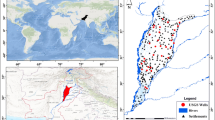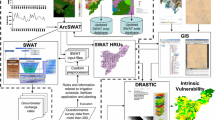Abstract
The Río Artiguas basin in central Nicaragua shows a distinctive case of environmental deterioration due to anthropogenic activities. Heavy metals used in gold mining and other wastes are continuously released into the rivers, representing a threat to the water quality. This article aims to evaluate the groundwater intrinsic vulnerability in the Río Artiguas basin and to provide information for sustainable use of water resources. The DRASTIC and GOD methods were used to analyse the relative pollution potential within the basin. DRASTIC was modified to include the degree of influence that geological structures have on the vulnerability. Moderate vulnerability areas cover most of the basin along stream valleys and lowlands, increasing downstream in the basin. The resulting vulnerability maps show that the limited groundwater resources are susceptible to surface water pollution as high vulnerability areas converge along the river valleys.








Similar content being viewed by others
References
Aller L, Bennet T, Hehr JH, Petty RJ, Hackett G (1987) DRASTIC: a standardized system for evaluation groundwater pollution potential using Hydrogeologic Settings, U.S. Environmental Protection Agency, Ada. Ok, EPA/600/2-87-036, 455pp
Allison GB, Hugues MW (1978) The use of environmental chloride and tritium to estimate total recharge to an unconfined aquifer. Aust J Soil Res 16:181–95
Civita M, De Maio M (2004) Assessing and mapping groundwater vulnerability to contamination: The Italian “combined” approach. Geofísica Int 43(4):513–532
Civita M, De Regibus C (1995) Sperimentazione di alcune metodologie per la valutazione della vulnerabilità degli aquiferi (in Italian). Quad Geol Appl Pitagora Ed Bologna 3:63–71
Corniello A, Ducci D, Napolitano P (1997) Comparison between parametric methods to evaluate aquifer pollution vulnerability using GIS: an example in the ‘‘Piana Campana’’, southern Italy. In: Marinos PG, Koukis GC, Tsiambaos GC, Stournaras GC (eds) Engineering geology and the environment. Balkema, Rotterdam, pp 1721–1726
Darce M (1990) Mineralogic alteration patterns in volcanic rocks of the La Libertad gold mining district and its surroundings, Nicaragua. Econ Geol 85:1059–1071
Davis AD, Long AJ, Wireman M (2002) KARSTIC: a sensitivity method for carbonate aquifers in karst terrain. Environ Geol 42(1):65–72
Deutsch CV, Journel AG (1992) GSLIB geostatistical software library and user’s guide. Oxford University Press, New York
Desbarats AJ, Logan CE, Hinton MJ, Sharpe DR (2002) On the kriging of water table elevations using collateral information from a digital elevation model. J Hydrol 255:25–38
Dixon B (2005) Groundwater vulnerability mapping: a GIS and fuzzy rule based integrated tool. Appl Geogr 25(4):327–347
Ehrenborg J (1996) A new stratigraphy for the Tertiary volcanic rocks of Nicaraguan Highlands. Geol Soc Am Bull 108(7):830–842
Foster SSD (1987) Fundamental concepts in aquifer vulnerability, pollution risk and protection strategy. In: van Duijvenbooden W, van Waegeningh HG (eds) TNO Committee on hydrological research, The Hague. Vulnerability of soil and groundwater to pollutants, Proc Inf 38, pp 69–86
Forster CB, Evans JP (1991) Hydrogeology of thrust faults and crystalline thrust sheets: results of combined field and modeling studies. Geophys Res Lett 18(5):979–982
Foster SSD, Hirata R, Gomes D, D’Elia M, Paris M (2002) Groundwater quality protection; a guide for water utilities, municipal authorities and environment agencies. The World Bank, Washington, p 103
Gaye CB, Edmunds WM (1996) Groundwater recharge estimation using chloride, stable isotopes and tritum profiles in sands of northwestern Senegal. Environ Geol 27:246–251
Gogu RC, Dassargues A (2000) Current trends and future challenges in groundwater vulnerability assessment using overlay and index methods. Environ Geol 39(6):549–559
Gogu RC, Dassargues A (2003) Comparison of aquifer vulnerability techniques. Application to the Néblon river basin (Belgium). Environ Geol 44:881–892
Goovaerts P (1997) Geostatistics for natural resources evaluations. Oxford University Press, New York
Grunander K, Nordenberg L (2004) Investigation of groundwater–surface water interaction in the drainage basin of the River Sucio, Nicaragua, MSc thesis, ISRN LUTVDG/TVTG-5090-SE, Lund University, Sweden, p 92
Hodgson G (1972) Mapa Geológico de La Libertad [Geological map of La Libertad] Catastro e Inventario de Recursos Naturales. Managua, Nicaragua (in Spanish)
Ibe KM, Nwankwor GI, Onyekuru SO (2001) Assessment of ground water vulnerability and its application to the development of protection strategy for the water supply aquifer in Owerri, Southeastern Nigeria. Environ Monit Assess 67:323–360
INETER (1973) Estudio Edafológico de la Cuenca del Río Escondido [Edaphology study of the Río Escondido basin]. Instituto Nicaragüense de Estudios Territoriales- Ministerio de Agricultura y Ganadería Departamento de Suelos y Taxonomía/Catastro, Nicaragua (in Spanish)
INETER (1991) Anuarios Meteorológicos (1990–1991) [meteorological charts]. Managua, Nicaragua (in Spanish)
Levens R, Williams R, Ralston D (1994) Hydrogeologic role of geologic structures. Part 1: The paradigm. J Hydrol 156(1–4):227–243
MapInfo (2000) Mapinfo professional ver. 6.0 software documentation. New York
Mendoza JA (2002) Geophysical and hydrogeological investigations in the Rio Sucio watershed, Nicaragua. Lic Thesis ISBN 91-972406-0-X, Lund University, Sweden, 60pp
Mendoza JA, Bjelm L, Dahlin T (2000) resistivity imaging as a tool for groundwater studies at Santo Domingo, central Nicaragua. Paper presented at the EEGS Bochum, Germany, 7–14 September 2000
Mendoza JA, Dahlin T, Barmen G (2004) Use of resistivity imaging in a surface water–groundwater interactions study. Paper presented at the XXXIII Congress IAH - 7° ALHSUD, Zacatecas City, Mexico, 11–15 October, 2004
Mendoza JA, Dahlin T, Barmen G (2005) Hydrogeological and hydrochemical features of an area polluted by heavy metals in central Nicaragua. Hydrogeol J. DOI 10.1007/s10040-005-0462-5
Rosén L (1994) A study of the DRASTIC methodology with emphasis on Swedish conditions. Ground Water 32(2):278–284
Secunda S, Collin ML, Melloul AJ (1998) Groundwater vulnerability assessment using a composite model combining DRASTIC with extensive agricultural land use in Israel’s Sharon region. J Environ Manage 54:39–57
Vrba J, Zaporozec A (1995) Guidebook on mapping groundwater vulnerability. IAH, Int. Contrib. to Hydrogeol., 16 (1994). Heise, Hannover, p 131
Weinberg RF (1992) Neotectonic development of western Nicaragua. Tectonics 11:1010–1017
Acknowledgements
This work was conducted as part of a multidisciplinary research program funded by the Swedish International Development Agency (Sida/SAREC). Technical and logistical support was provided by the Department of Engineering Geology at Lund University (Sweden) and Centro de Investigaciones Geocientíficas at UNAN-Managua, respectively. Dr. Torleif Dahlin offered valuable guidance. Emilio Pichardo, Meyling Herrera, Walter Espinoza, Martha Sánchez and Santiago Noguera collected important field data. Family Perez-Martínez is specially acknowledged as their assistance made fieldwork less difficult under the tropical conditions at Río Sucio. The contributions from three anonymous reviewers are acknowledged.
Author information
Authors and Affiliations
Corresponding author
Rights and permissions
About this article
Cite this article
Mendoza, J.A., Barmen, G. Assessment of groundwater vulnerability in the Río Artiguas basin, Nicaragua. Environ Geol 50, 569–580 (2006). https://doi.org/10.1007/s00254-006-0233-1
Received:
Accepted:
Published:
Issue Date:
DOI: https://doi.org/10.1007/s00254-006-0233-1




